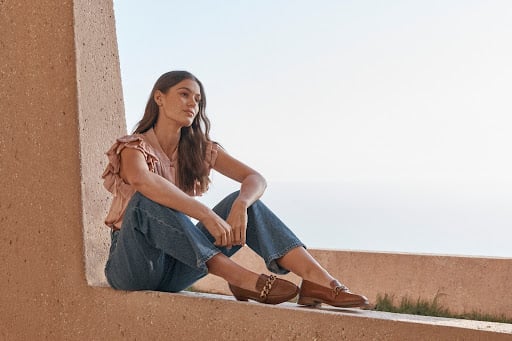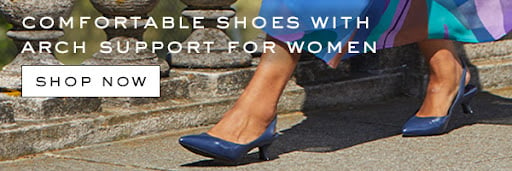If you took a close look at your favorite pair of shoes, do you think you could name all of its parts? Sure, you might know that the sole is the bottom of the shoe or that the laces are what keep it fastened. You might even know where the toe box is. But do you know what the upper part of your shoe is called and the major role that it can play in the comfort and fit of your footwear?
Believe it or not, the upper portion of your shoe, more commonly known as the vamp, affects the look and fit of your shoe, as well as the way your foot feels in the shoe.
Don’t worry—if you’re still asking yourself, “But exactly what is a vamp on a shoe”, we’re using this article to get to the bottom of the top of your footwear.
What Does It Mean for a Shoe to Have a Vamp?
Let’s start with the basics of shoe terminology—what exactly is a vamp? To put it simply, in shoe anatomy, the vamp is another name for the top part of the shoe.
Almost all footwear is made up of some of the same basic shoe parts, which include:1
- Vamps – Also known as uppers, vamps are the top portion of the shoe that stretches from the toe to wherever the shoe ends on your foot. Depending on the style and shape of the particular shoe you’re wearing, the vamp may look totally different or cover different parts of the foot.
- Soles – Soles are the bottommost part of your shoe, and they’re typically made from materials like rubber, leather, or PVC. Soles might also have other features, like treads for non-slip traction or extra padding to absorb shocks.
- Toe box – The toe box is found in the frontmost part of the shoe and refers to the space reserved for the toes.
- Collar – Collars aren’t just for your neckline—the collar of a shoe refers to the opening in the shoe that you insert your foot into. For closed shoes like athletic sneakers or travel walking shoes, this opening might be cushioned for extra comfort.
Depending on the style of the shoe and how it’s intended to look or fit on the foot, a shoe vamp can be completely different from one pair to the next. For instance, a pair of traditional sneakers made for hitting the gym might have a very high vamp that covers the entire foot, while a trendy pair of peep-toe mules may have a lower vamp for a flash of skin.
Interestingly enough, the kind of vamp your shoes sport (i.e. a high vamp vs a low vamp) can have a serious impact on your foot health. If you can’t tell a high vamp from a low vamp, don’t worry—we’ve got your guide to cracking the code on this footwear fixture below
What Is a High Vamp Shoe?
Do you own a pair of Mary Janes? How about a pair of Oxfords or loafers? If the answer to any (or all!) of these is yes, you’ve got a pair of high vamp shoes in your closet.
High vamp shoes are those whose upper level starts at the tip of the toe box and covers all or some of the top of the foot.2 This might look a little different depending on the type of shoe you’re wearing. For example:
- Closed-toed shoes like sneakers or loafers have vamps that fully cover the foot, starting from the toe and going to just below the ankle, leaving no gaps or visible skin.
- Ankle boots also feature vamps that cover the foot entirely, but then extend on to cover up to the ankle or even just beyond it.
- Some shoes, like Mary Janes with their peekaboo-style windows and buckled straps, are considered high vamp even though their design doesn’t fully hide the foot. This is because some portion of the shoe vamp still covers the foot—in this case, the straps that stretch across the midfoot.
- Many types of sandals, including gladiator sandals, are considered high vamp shoes thanks to straps that stretch across the top part of the foot.
How Does Wearing a High Vamp Shoe Affect My Feet?
If you’re seeking a shoe that’ll provide unparalleled support and structure, a high vamp shoe will be your best bet. This is because shoes like these do a better job of keeping the foot from moving out of place or slipping out of the shoe when performing certain activities, like walking.
Shoes with vamps that go up to or above the ankle provide an additional layer of stability that makes them ideal for those who need a bit more structure. To that end, you might give preference to high vamp shoes if:
- You have a foot structure that might lead to wobbliness or instability, like weak ankles or overly arched feet.
- You’re prone to over-supination, or rolling the foot and ankle out excessively when walking. If uncorrected, this can make you more likely to roll your ankle, which can lead to a sprain or even a break.
- You suffer from any recurring, chronic foot condition like plantar fasciitis (inflammation and pain in the tendon along the sole of the foot, known as the plantar fascia). A good tip to keep in mind when dealing with foot issues like this is to always seek out shoes with more stability and structure.
How Do I Style High Vamp Shoes?
Because high vamp shoes tend to visually cut the foot off with straps or long upper pieces, they can pose a tricky styling conundrum. To avoid a shortened foot appearance and keep your legs looking miles long, try to pair high vamp shoes with shorter bottoms—think shorts, cropped jeans, or mini skirts.
Here’s how we like to style three of our favorite high vamp pieces:
- Pair a classic suede ankle bootie like the Vionic Cecily Ankle Boot with a pair of cropped jeans and a wrap-style blouse for a look perfect for heading out on the town.
- Slip into summer with the Vionic Isadora Wedge Sandal, which features a leather vamp with an arch-hugging sole for maximum comfort. Wear this heeled sandal with a flowy mini skirt and a tank for an easy, breezy warm weather outfit.
- On the go and need maximum comfort and flair? Try the Groove Slip On Sneaker—these canvas sneaks look great paired with your favorite denim cutoffs and a comfy tee.
What Is a Low Vamp Shoe?
While high vamp shoes either cover the entire foot or some of the foot between the toes and the ankles, low vamp shoes do the opposite. In other words, low vamp shoes typically only cover the toes, leaving the rest of the foot bare and uncovered.
The most common types of low vamp shoes are shoes like ballet flats or classic pumps, which feature a vamp that stops just after the toe. Believe it or not, tall boots are also considered low vamp shoes if they go to the knee or higher. This is because they feature a single, unbroken line from toe to knee.
How Does Wearing a Low Vamp Shoe Affect My Feet?
Low vamp shoes aren’t quite as stable or supportive as high vamp shoes. Since they don’t offer as much in the way of structure, they don’t do as much to protect the foot against injury. Because of this, you might want to choose a high vamp shoe over a low vamp shoe for instances when you’ll be doing a lot of walking or getting pretty active.
But don’t count out low vamp shoes altogether! You can ensure your low vamp shoes are as foot-friendly as possible by:
- Seeking out options with excellent arch support
- Steering clear of sky-high heels
If you feel your shoe needs a little extra oomph to better cushion your feet, you can also consider adding an insole. We recommend looking for an insole that features podiatrist-designed arch support while still being low profile enough to wear with your dress shoe, like the Vionic Slim Fit Insole.
How Do I Style Low Vamp Shoes?
Low vamp shoes do have one major advantage—their low profile shape can seriously elongate the legs, making for a head-turning, lengthened silhouette. Here are some of our favorite ways to wear low vamp styles:
- Pair a knee-high boot like the Inessa Tall Boots in soft wheat with an A-line dress for a 60s glam-inspired look.
- A pair of black slingbacks like the Ziva Kitten Heels is a classic for a reason. Pair these comfy yet elegant shoes with a midi skirt and a bold red lip.
- Looking for a style that’s equal parts casual and polished? Coming in seven different colors and prints, there’s a Minna Ballet Flat for just about every occasion (and every outfit). Wear these ballet flats with a pair of cropped skinny jeans and a white tee for an outfit that combines French girl cool with all-day walkability and comfort.
Step Out in Style With Vionic
Don’t let confusion over vamps trip you up— knowing what they are and how they work as part of a great pair of shoes can help you pick out the best footwear for your feet (as well as your desired look).
Whether you’re pairing structure and style with high vamp boots or making a statement with low vamp ballet flats, you’re always sure to stun when you wear Vionic.
At Vionic, we’re all about creating shoes and insoles that make sure your feet feel as great as they look. No matter what shoe style or shape you’re into, you’re sure to find something you love in our collection of trend-forward, podiatrist-trusted footwear. Support your feet the way they deserve when you explore our collection today.
Sources:
- “Anatomy of the Shoe.” Shoe Guide. https://www.shoeguide.org/shoe_anatomy/
- “What Is Shoe Vamp and Why Does It Matter?” Inside Out Style. https://insideoutstyleblog.com/2016/08/what-is-shoe-vamp-and-why-does-it-matter.html



Leave a Reply